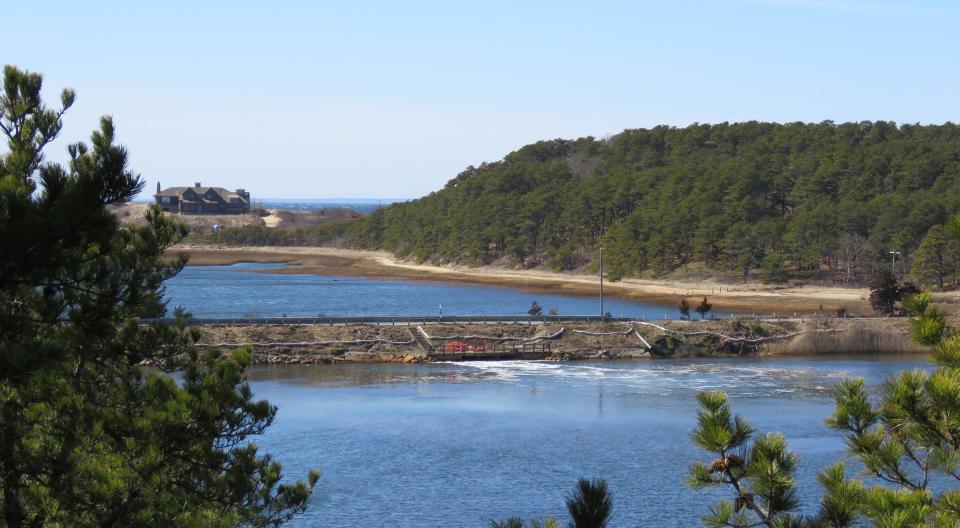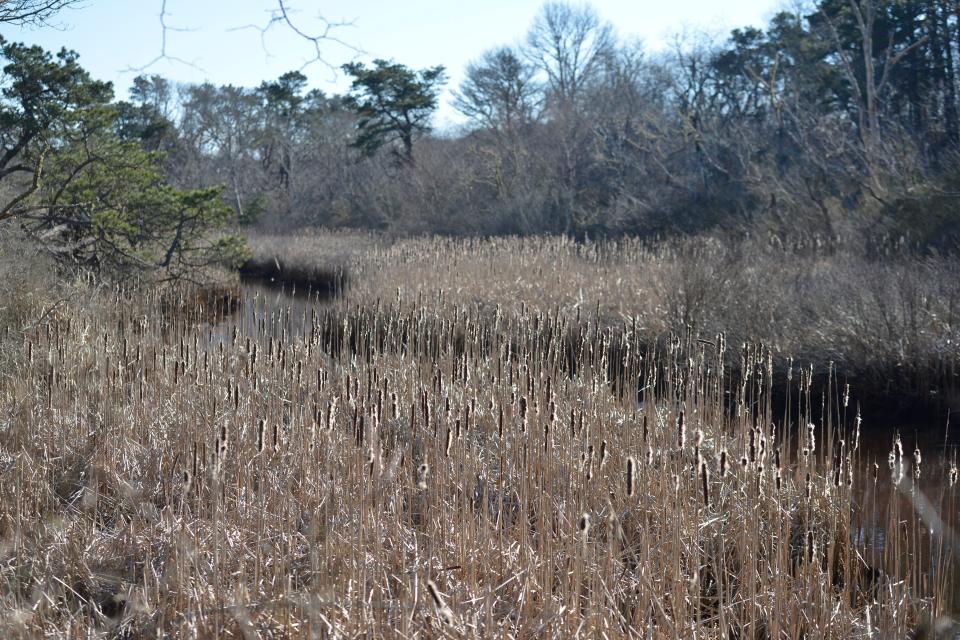After 20 years of planning, Wellfleet celebrates start of Herring River restoration project
Restoration of the Herring River estuary is taking a big step forward with the start of work for a new bridge at Chequessett Neck in Wellfleet.
On Friday, local, state and federal officials will join with project partners off Chequessett Neck Road, officially to celebrate groundbreaking for the bridge, which is viewed as a project milestone. The event takes place 11 a.m.-12 p.m.
The Herring River estuary restoration project, estimated to cost $60 million, aims to restore 890 acres of degraded salt marsh and other estuarine habitats, mostly within the Cape Cod National Seashore in Wellfleet and part of Truro. Ultimately, it will improve water quality, enhance climate resiliency, and restore native vegetation and shellfish harvesting, according to advocates.

The bridge construction at the Herring River in Wellfleet has begun.
The town and its contractor, Acton-based MIG Corporation, Inc., started work at the site of the new $31 million bridge on March 1, funded with grants from the U.S. Department of Agriculture Natural Resource Conservation Service and the Massachusetts Division of Ecological Restoration. The USDA is working in partnership with the Cape Cod Conservation District and the Barnstable County Board of Regional Commissioners on the project.
The bridge, which will have sluice gates to manage the rate of tidal exchange between Wellfleet Harbor and the estuary, will replace the Chequessett Neck Road earthen dike. That tidal interchange was interrupted when the dike was constructed in 1909 to control mosquitoes and create more arable and developable land.
The new bridge is a keystone in the eventual restoration, and the start of work on it comes as a momentous occasion for those involved with the project.
More: Ducks Unlimited brings $2M, expertise to Wellfleet salt marsh restoration
"Seeing the bridge construction get under way is very rewarding for the town, the Cape Cod National Seashore and our other state and federal partners who have worked for more than two decades to reach this point," said Wellfleet Town Administrator Richard Waldo.
"After about 20 years of planning, it's very exciting," said Christa Drew, executive director of the Friends of Herring River, a nonprofit and lead supporter.
A temporary bypass bridge will be built at the Herring River in Wellfleet.
According to the town, the two-year bridge construction plan calls installing a temporary bypass bridge this spring and summer for vehicles and pedestrians. Fish passage will be maintained throughout construction.
It's all part of the first phase of the restoration project.
All about the project Herring River restoration project gets a hefty $22.67M boost from state
"Phase 1 will restore 570 acres of degraded marsh in the estuary, and includes all water control infrastructure needed to restore the full 890 acres," Waldo explained.
The project also calls for installing new culverts with tide gates for the Upper Pole Dike and Mill Creek areas.
The second phase will include measures to protect low-lying roads and structures in Wellfleet and Truro from increased water levels. Waldo said there is no set timeline for that work, as it will depend on the duration of the first phase. The low-lying road sections are mostly along Pole Dike Road, Bound Brook Island Road, Old County Road and a few sections of secondary roads.
So far, there is a three-year plan for how higher tides will be introduced into the Herring River estuary.
Once the new bridge is complete the tidal flow will be incrementally increased over time. "There are many different steps to restore the natural tidal flow," Drew said.
Waldo noted there is a tide gate management policy, adopted by the Herring River Executive Council, that outlines how tidal flow will be reintroduced. Initially, the policy governs the first three years of tidal restoration, he said.

"Over the course of the first year, tide levels in Lower Herring River will be increased to a point where they just begin to overflow stream and creek banks and begin to flood the marsh surfaces, enabling restoration to begin," Waldo explained. "This tide level will then be maintained for two years to allow data collection to inform the next stage of tide gate management."
The process could take six to 10 years "to really see what we would consider a fully healthy (saltmarsh) ecosystem" there, Drew said.
Chequessett Neck Road will remain open
During the bridge construction, Chequessett Neck Road will remain accessible, though motorists can expect temporary lane closures at times. The town will provide ongoing construction updates and lane closure alerts on its website at https://www.wellfleet-ma.gov/.
Environmental Partners of Quincy is providing construction oversight. Questions about construction work can be emailed to wcs@EnvPartners.com.
Gain access to premium Cape Cod Times content by subscribing.
This article originally appeared on Cape Cod Times: Herring River river, wetland project starts with Wellfleet celebration

